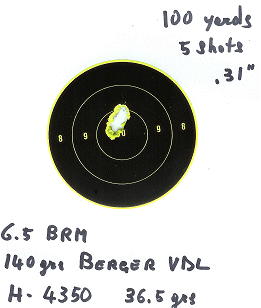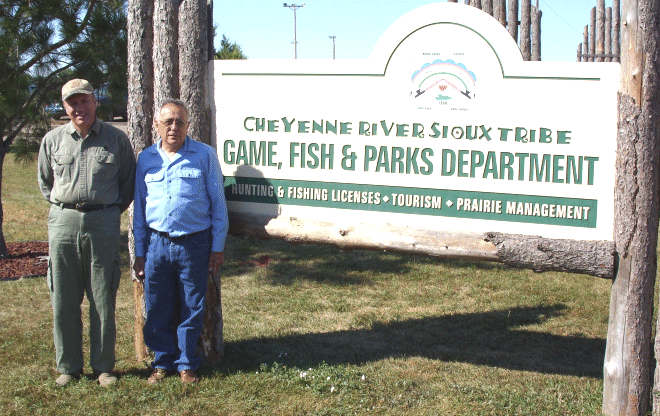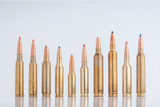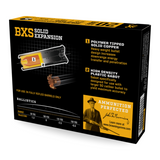6.5mm BRM and 97D at 700 Yards (Video)
Andrea Giambi (Andy), Bob Fontanini, and me (Eben Brown) originally planned to video a 1,000 yard shot. Andy had worked up a really accurate load in 6.5mm BRM for his 97D rifle but the South Dakota wind was gusting to 40 mph. We finally were able to set up for a downwind shot at a measured 700 yard distance. We chose a gallon of milk for a target so that a hit would produce a bright white explosive reaction... And it worked! The impact of 6.5mm BRM at 700 yds is dramatic!
In the video, you will see the first few shots that missed within inches...
| I left the misses in the video for two reasons: First to show how nearly "Right On" you can be with good preparation and an accurate rifle. But also to give credibility to the video. 700 yards is a heck of a long shot with swirling wind and mirage pushing the bullet and distorting the target. The scope crosshair is nearly the same size as the milk jug and a single click of scope adjustment moves the point of impact almost 2 inches. Down range, the sound of the shot arrives at the same time as the bullet. But from the shooter's perspective there is a definite time delay between hearing the shot and seeing the impact... That's "time of flight". You'll see that effect near the end of the video when we show Giambi at the bench and the target as an inset.
Finally, I've written up an article on the equipment, ballistic science and skill that went into making this shot and posted it below... I hope you enjoy the video! |
The Accuracy Combination: Rifle, Load, and Skill......
Ballistic Science and Modern Riflescopes
| "How far does the bullet drop at 700 yards?" Actually, it doesn't drop at all... If you're sighted in properly. Consider that the bullet hits right at your point of aim if your rifle is zeroed for 700 yards! I realize that statement seems silly but it really isn't far from the truth in long range shooting. Nowadays we have computers and apps that can calculate a bullet's trajectory. We can use this information to adjust our point of aim (hold over). Using this method, we'll have to account for bullet drop at some distance but, the amount of "drop" is still going to depend on what range we have the rifle zeroed for. To calculate a trajectory, you will need the actual muzzle velocity and the ballistic coefficient (BC) of the bullet. You can measure the velocity with a chronograph. The BC of your bullet is available from the bullet manufacturer on-line or from your reloading manuals. Taking computer calculated trajectories to another level, a good riflescope has repeatable elevation adjustments (such as target knobs). Armed with such a scope and a trajectory chart, you can simply dial in the number of clicks to zero the scope for the distance you are shooting. And then just aim right on with no holdover. For example, you might zero for 200 yards and adjust your scope UP by 50 clicks to be zeroed for 500 yards. The markings on target knobs and 1/4 MOA clicks make this pretty easy to do... At 500 yards it is a little less than one full turn. |
Perhaps a more convenient approach to using calculated trajectories is the use of ballistic reticles. These are riflescopes where the reticle has different aiming points for different distances. We offer a very reasonably priced riflescopes in this category... the Hawke Vantage. You can download the software free if you'd like to see how this works without having to buy the scope. And probably the finest ballistic reticle systems in the world comes on the more expensive HorusVision rifle scopes. For the 700 yard Milk Jug shot, Andy was using his pride and joy HorusVision Hawk riflescope. By now you are probably realizing the need for some way to accurately measure the distance to the target... If you don't know the distance, all of the calculated trajectories and ballistic reticles are useless! We recommend a good quality Laser Rangefinder... they're very accurate. All of this stuff is truly amazing... It illustrates the extreme possibilities of an accurate rifle and cartridge. And it's just nice to know your equipment can do it. But sooner or later you come back to the question of what is the simplest, most practical answer for hunting? I tell customers to zero their 6.5mm BRM for 200 yards. This will make it 3 inches high at 100 yards and 10 inches low at 300 yards. For deer hunting, you aim right on all the way out to 250 yards. Aim at the spine at 300 yards and you'll hit the middle of the chest. Simple. |
The Importance of a Solid Rest...
| For long distance shooting, its important to realize that very small errors become big misses down range. The human element is the main source of small errors such as tension input, heart beat, flinch, jerk, breathing, buck fever, and whatever. By using a shooting rest, you can remove most of the human errors from your hold. See our Bipods and Rests for Bulls Bags, Bench Rests, Bipods, and Gun Resting Accessories.
|
Recent Posts
-
6.5mm Cartridge Comparison
6.5mm Cartridge Comparison (Pictorial Overview) A Quick Look at Popular 6.5mm Rifle Cartridges Vis …Aug 11th 2025 -
Rethinking Shotgun Slug Accuracy: Why Slower Might Be Better
Last year the Browning slugs I ended up using were a departure from conventional thinking but they …Jun 12th 2025 -
The Timeless Appeal of the .308 Winchester: Why This Cartridge Endures
The .308 Winchester, introduced in 1952, has become one of the most enduring cartridges in firearms …Jul 11th 2024




